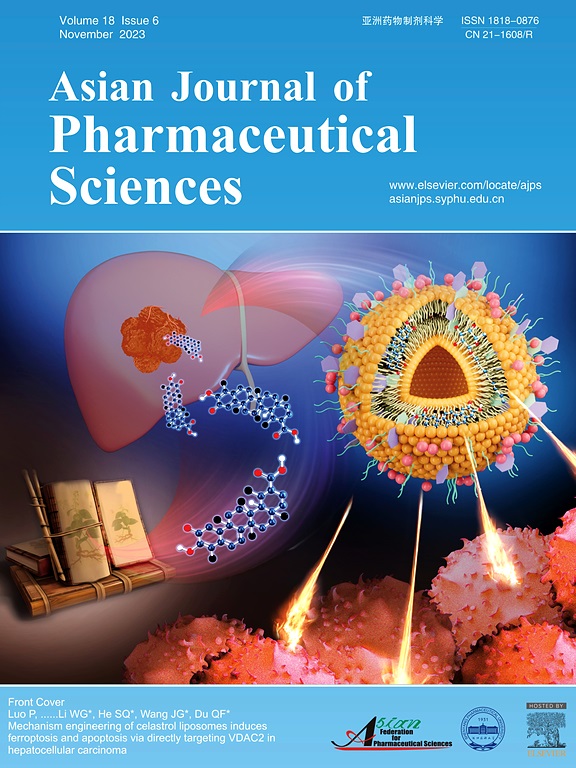透明质酸与油酸取代缀合物作为改善环孢素A与油酸眼部共递送的新型纳米材料
IF 11.9
1区 医学
Q1 PHARMACOLOGY & PHARMACY
引用次数: 0
摘要
通过半胱胺(CYS)连接剂,制备了透明质酸(HA)与不同比例油酸(OA)的结构偶联物(HOC),作为一种新型眼部生物材料。合成了OA取代度可控的hoc(4.6%, 8.3%和12.2%),形成了自组装的HA-CYS-OA纳米粒子(HONs, HON1, HON2, HON3)。选择一种用于治疗多因素干眼病(DED)的低水溶性环孢素A (CsA)作为模型药物。与Restasis®相比,csa负载的HON通过HON的增溶能力提高了溶液透明度,并增加了体外药物渗透。负载csa的HONs的理化性质,如纳米行为、溶液透明度、药物释放、药物渗透和眼细胞相容性等,随着OA取代率的不同而发生很大变化。有趣的是,这种负载CsA的HON1作为最佳眼部纳米制剂,可以显著增强巨噬细胞向M2表型的极化,下调lps诱导的M1巨噬细胞中促炎细胞因子的表达水平,同时通过CsA和含OA的HON1的协同作用,有效抑制vegf诱导的内皮细胞增殖和毛细血管样管的形成。综上所述,目前与透明质酸缀合的脂肪酸被称为脂化平台,通过透明质酸的结构特征提供了其作用和理化性质,可能是一种很有前景的药物与脂肪酸共给药策略,用于DED和其他眼科疾病的治疗。本文章由计算机程序翻译,如有差异,请以英文原文为准。

Hyaluronic acid conjugates with controlled oleic acid substitution as new nanomaterials for improving ocular co-delivery of cyclosporine A and oleic acid
A structural conjugate (HOC) of polysaccharide, hyaluronic acid (HA) with different ratios of oleic acid (OA) via cystamine (CYS) linker as a new ocular biomaterial was developed. The HOCs with controlled degrees of substitution of OA (4.6 %, 8.3 % and 12.2 %) were synthesized to form self-assembled HA-CYS-OA nanoparticles (HONs, HON1, HON2, HON3). A poorly water-soluble cyclosporine A (CsA) to be used for the treatment of multifactorial dry eye disease (DED) was chosen as model drug. CsA-loaded HONs exhibited improved solution transparency via solubilizing capacity of HON, and increased in vitro drug permeation compared to Restasis®. The physicochemical properties of CsA-loaded HONs such as nano behaviors, solution transparency, drug release, drug permeation and ocular cytocompatibility were highly variable according to the ratios of OA substitution. Interestingly, this CsA-loaded HON1 as optimal ocular nanoformulation showed markedly augmented macrophage polarization into the M2 phenotype, downregulated the expression of proinflammatory cytokines levels in LPS-induced M1 macrophage, and effectively inhibited VEGF-induced endothelial cell proliferation and capillary-like tube formation by the synergistic effect of CsA and HON1 containing OA at the same time. Collectively, the current fatty acid conjugated to HA, named fattigation platform, providing the roles and physicochemical properties via structural features of HA could be a promising co-delivery strategy of drug and fatty acid for DED and other ophthalmic disease treatments.
求助全文
通过发布文献求助,成功后即可免费获取论文全文。
去求助
来源期刊

Asian Journal of Pharmaceutical Sciences
Pharmacology, Toxicology and Pharmaceutics-Pharmaceutical Science
CiteScore
18.30
自引率
2.90%
发文量
11
审稿时长
14 days
期刊介绍:
The Asian Journal of Pharmaceutical Sciences (AJPS) serves as the official journal of the Asian Federation for Pharmaceutical Sciences (AFPS). Recognized by the Science Citation Index Expanded (SCIE), AJPS offers a platform for the reporting of advancements, production methodologies, technologies, initiatives, and the practical application of scientific knowledge in the field of pharmaceutics. The journal covers a wide range of topics including but not limited to controlled drug release systems, drug targeting, physical pharmacy, pharmacodynamics, pharmacokinetics, pharmacogenomics, biopharmaceutics, drug and prodrug design, pharmaceutical analysis, drug stability, quality control, pharmaceutical engineering, and material sciences.
 求助内容:
求助内容: 应助结果提醒方式:
应助结果提醒方式:


